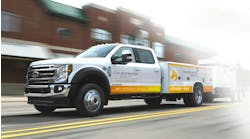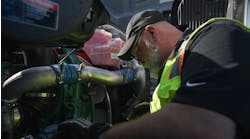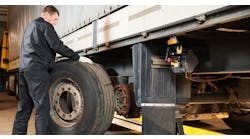Even with the best maintained equipment, breakdowns and the need for roadside assistance will inevitably occur. Because driver and vehicle downtime is expensive, drivers and vehicles need to get back on the road quickly and cost effectively, with minimal disruption to fleet operations.
Some fleets handle emergency roadside assistance in-house. Others outsource this function to third parties that specialize in one-stop solutions for breakdown and emergency roadside assistance.
Third-party services tend to offer 24/7 support every day of the year through a toll-free telephone number or Internet access. They handle everything through integrated services that address the entire vehicle breakdown process - from diagnosis to vendor management and billing. They also monitor the progress of every event by following up with the driver/dispatch/maintenance function and service provider until the repair or service is completed.
PROCESS MANAGEMENT
“The goal of getting trucks back on the road as quickly and safely as possible hasn’t changed, but the process of managing breakdowns today is much different than it was just 10 years ago,” observes Jason Manuel, national sales manager for InterStar North America, a provider of maintenance and repair solutions for the commercial trucking industry.
“When a driver needs to get off the highway because of a vehicle problem, the first priority is to find out exactly where he or she is,” he says. “Determining a precise location 10 years ago meant the driver had to pull out a paper map, get on the CB to get help from other drivers or walk up and down the highway to find a mile marker post.”
“The road atlases and simple mapping software of the not-too-distant past has quickly given way to more accurate GPS, online locator software and real-time tracking of fleet assets,” adds Don Darden, executive director, communications, for Bridgestone Americas, which operates the Bridgestone Bandag Tire Solutions Emergency Road Service program. “Technology has also allowed us to monitor calls more efficiently and shorten the downtime associated with breakdowns. It has enabled the tracking and reporting of breakdown information to become actionable and allow fleets to make more data driven decisions.”
Nowadays, drivers can instantly determine their location with assistance from satellite platforms and GPS-enabled devices, Manuel says. Modern breakdown call centers often utilize advanced mapping solutions to help locate the driver and the closest mobile or drive-in repair facility.
“Taking less time to determine the breakdown location and problem reduces the amount of time the vehicle sits on the side of the road,” he says.
COMMUNICATION INTEGRATION
The expanding use of the latest in communication and computer technology enables a smooth, seamless flow of information between fleet and maintenance systems to enable breakdown services to become true partners with their customers, says Heather Holt, director of marketing for FleetNet America, a third-party vendor management company that coordinates emergency roadside service and maintenance management service for commercial equipment.
“The integration with the satellite communications providers allow drivers to communicate breakdown needs in the same manner they use to communicate with dispatch, eliminating the need for traditional phone calls,” she says.
Some new in-cab offerings actually monitor engine fault codes and transmit them to fleet managers and breakdown companies, notes Manuel of InterStar North America.
By way of example, national less-than-truckload motor carrier Old Dominion Freight uses PeopleNet’s real-time engine monitoring to enable FleetNet America to proactively manage its fleet maintenance and reduce maintenance costs.
PeopleNet is the leading provider of innovative and integrated onboard computing and mobile communications systems for fleet management.
PeopleNet’s Vehicle Management application collects fault code information from the vehicles’ ECM (electronic control module) and sends the data to FleetNet over the PeopleNet network, FleetNet America’s Holts explains. FleetNet interprets the data and immediately contacts and instructs the driver of the vehicle with the fault code alarm to pull over and park the vehicle. The usual result is minor repair costs, compared to a component or engine failure that might have occurred if attention to the problem had been deferred until later.
In setting things up, Old Dominion’s maintenance department identified urgent fault codes that could result in catastrophic engine failure and should be sent to FleetNet America immediately: high temperature, low coolant, low oil pressure and high oil temperature.
“The fault code gives FleetNet America a better idea of what’s needed,” says Old Dominion director of field maintenance Tom Newby. “The last thing we want to do is have a technician dispatched to the truck only to learn that it can’t be fixed at roadside and will need a tow. It’s all about better visibility and analysis that will keep our maintenance costs and vehicle/driver downtime in check.”
FOLLOW UP
Technology also allows more thorough follow up, and helps to ensure that emergency roadside assistance events are tracked throughout the process, says Clive Guest, emergency road services manager for Michelin, which designs, manufactures and sells tires for every type of vehicle. There is direct communication with service technicians, and customers have the opportunity to see their events online or receive a detailed monthly report to improve their tracking and decision-making.
Using the latest in communication and computer technology for rapid roadside assistance, each and every call can be tracked in real-time and that information is easily available to fleet managers, adds Michael Stevens, director of Goodyear fleetHQ, Goodyear's portfolio of business solutions, which includes tire-related emergency road-assistance service. That allows fleet to make better business decisions.
Graphs and spreadsheets can be emailed monthly, quarterly or yearly, giving detailed information about a fleet’s equipment, Holt of FleetNet adds. Failures can be sorted, grouped and layered in many ways, such as by location, customer size and type of operation, and equipment make and model. “With this information, customers can prevent future breakdowns by changing their engine parameters and spec’ing their equipment differently.”
With the use of VMRS (Vehicle Maintenance Reporting Standards), some breakdown service providers, like FleetNet America, are able to apply costs to emergency roadside events more precisely across all vehicle types. “Customers will benefit through more detailed analysis of their maintenance costs which will give them more control over their expenses, says Holt.
Developed by the Technology & Maintenance Council, VMRS is a standard coding convention for universally tracking equipment and maintenance costs and functions.
VENDOR SELECTION
In general, breakdown services interview prospective vendors before being brought online as service providers. They may even contact current customers of these vendors to obtain further reference information.
Selection of vendors to handle events depends on several factors, says FleetNet’s Holt. “As an example, it is obviously best for a warranty repair to be handled by a provider that is authorized by the OEM to handle such repairs. Likewise, it is best for an event with windshield issues to be handled by a supplier specializing in windshield repair rather that by a general vendor. FleetNet matches the right provider with the desired service on a case-by-case basis.”
Each vendor is ranked in FleetNet’s system based on price, downtime, quality of work, etc. This enables the company to continually monitor the quality of its vendor network.
InterStar qualifies and monitors service vendors on several levels, including price, timeliness and quality of workmanship, says the company’s Manuel. “We have managed hundreds of thousands of breakdowns over the years so we have the data necessary to determine average costs and repair times for many types of services. Once we begin using a new vendor we’re able to monitor their performance compared to other vendors in their area.”
Michelin ONCall, the company’s 24-hour emergency road service, has a focus on the Michelin Commercial Service Network, a franchise network of commercial tire dealers, as part of its nationwide coverage. “Network dealers must adhere to rigorous certification standards, as well as undergo an audit process to ensure the highest level of service and product availability so that fleets can maximize their vehicles uptime,” says Michelin’s Guest.
With the Bridgestone Bandag Tire Solutions Emergency Road Service, all servicing dealers must be approved before being added to the emergency network, says the company’s Darden. Field audits and corporate reviews of both existing and new applicants also occur. Feedback from drivers, fleets and the road service dispatch department is collected and reviewed as well.
INCIDENT COORDINATORS
Individuals selected to man breakdown call centers and serve as incident coordinators are carefully selected. For Michelin ONCall, each person undergoes intensive initial and continuous training, ranging from phone technique to vehicle knowledge, says Guest of Michelin.
“Our incident coordinators, receive regular training related to new types of trucking equipment and industry best practices,” says InterStar’s Manuel. “Many of our employees have prior experience as heavy duty mechanics or as fleet maintenance managers and they provide knowledge and guidance for the entire team. New hires typically have industry experience and require several months of training before managing complex incidents.”
The call center personnel for Bridgestone Bandag Tire Solutions Emergency Road Service are all in-house Bridgestone personnel that are extensively trained in not only breakdown management, but are skilled in new tire, retread and vehicle knowledge, says Bridgestone’s Darden. The service looks for individuals who have exceptional customer service skills, plus strong case management and problem resolution skills.
FleetNet’s employees are mechanically trained and experienced, says the company’s Holt. Its in-house training department is responsible for mechanical training and passing along the latest OEM industry updates and equipment/component configurations, covering all Class 3 through Class 8 vehicles.
VEHICLE PROFILES
Typically, when a fleet registers with an emergency roadside assistance program it is able to create profiles for its vehicles, stating preferences and requirements for replacement parts, such as tires and other services and repairs, to expedite repairs. This allows for service to be provided in line with predetermined business rules from the fleet, says Michelin’s Guest.
Bridgestone Bandag Tire Solutions Emergency Road Service’s customized profile for customers contains standard contact and authorization information, such as e-mail, contact numbers, authorized approvers, etc., says Darden of Bridgestone. Fleets also have the ability to specify and customize which Bridgestone, Firestone and Bandag products they prefer by axle and wheel position, and are allowed to customize preferred vendors and any unique services pertinent to their needs.
“Because customers can establish servicing preferences for their trucks in their operator portfolios, fleets or owner-operators can simply tell the fleetHQ agent to follow their established preferences and the agent immediately knows what type, brand and size of tire is needed for replacement,” Goodyear fleetHQ’s Stevens says. “That saves operators the hassle of making several calls to find a location that’s open, or a tire dealer with the right tires in stock.”
“Every fleet is unique so it is important to build custom profiles with preference and guidelines for each fleet,” says InterStar’s Manuel. “Some fleets prefer new tires, others prefer retreads. Some fleets prefer to have major repairs handled on the side of the road and others prefer to have the units towed to a facility. It’s all a matter of preference that is built into the fleet’s custom profile.”
“Customized handling instructions for customers are necessary and range from the necessity of specific personnel allowed to make authorizations regarding repairs to their authorization limits on tires, towing and other needs,” FleetNet’s Holt adds. Other handling instructions include purchase order requirements, national tire accounts utilization, downtime requirements, etc.
REQUISITE SERVICES
When searching for a third-party breakdown program, the first thing a fleet should do is document all of their current breakdown processes, advises InterStar’s Manuel. Gather and document national tire account numbers and contact lists of the personnel who are going to be able to approve repair services.
“The next step is to review the sales literature and websites of popular breakdown companies, narrow the list to the two or three most intriguing,” he says. “Schedule meetings or phone conferences to find out what the provider can do for you and what costs are involved.”
Some discerning questions to ask a potential breakdown provider, says Manual, are:
- Will you be able to use your national tire accounts to purchase tires in an emergency situation?
- Are there any monthly or annual fees to join as a fleet customer?
- What type of contract or service agreement is involved with becoming a fleet customer?
- How will warranty situations be handled?
- What methods of payment are accepted?
- What types of services are provided? (Tire, mechanical, towing, accident recovery, etc.)
- Does the provider offer service at your terminal or just roadside emergency service?
- Can the company provide you with fleet references to vouch for its service?
RATING SYSTEMS
When considering a roadside service provider that best meets an organization’s needs, Karen Piccolomini, manager for RoadSquad, a comprehensive roadside service program, recommends developing a ratings system that reflects what you’re looking for in a provider. “It doesn’t have to be complex or in-depth. It can be as simple as 1, 2, 3. One, they’re a preferred supplier. Two, they’re a secondary choice. Three, they’re a provider that’s performed poorly in the past.”
A next step is to take a hard look at each service providers’ reputation, she says. “Do your research. Call around. Find out what their roadside capabilities are.”
It’s also important to learn about the quality of a provider’s technicians, points out Piccolomini. “Do they have the expertise to repair a blown tire or are they limited to fixing a flat? Do the technicians have the equipment and training needed to conduct remote diagnostic work? Do they have proper ASE certification? If they do, what is the average certification for that provider? Are their technicians trained in roadside safety?”
An additional consideration is the service provider’s service trucks, she adds. “Do they have the number of trucks and technicians needed to handle the inevitable uptick in business during extreme weather conditions - both hot and cold? Are they set up with safety in mind? Do they have quality equipment on board?
“How the service truck is equipped is a big part of an efficient and safe repair.”
FleetNet’s Holt says companies should consider the 10 Commandments of Outsourcing by Assistant Professor Robert J Eder III of the University of Wisconsin-Milwaukee when considering outsourcing transportation needs and “approach carefully.”
1. Develop a strategy for outsourcing.
2. Establish a rigorous provider selection process.
3. Clearly define expectations.
4. Develop a good contract.
5. Establish sound policies and procedures.
6. Identify and avoid potential points of friction.
7. Communicate effectively with your partner.
8. Measure performance and communicate results.
9. Motivate and reward the provider.
10. Be a good partner.
SERVICE RATES
Naturally, rates are a big issue with breakdown services.
Many emergency breakdown programs have service providers in their network that have pre-determined, negotiated service rates, as well as consistent or guaranteed pricing throughout the country so fleets can avoid “surprises” on the road and know what to expect ahead of time. Some programs charge a dispatch, incident, enrollment or membership fee.
Payment options for actual repair services vary. Authorization protocols can be specifically defined to suit a fleet’s business needs.
“When you make that phone call for roadside assistance, before hanging up, make sure you understand what you’ll be charged,” advises RoadSquad’s Piccolomini. “Many providers charge more after 5 p.m. and on weekends and holidays. There might be a call-out fee.”
Find out if the service has a two-hour minimum, she says. “That two-hour minimum is going to hurt if you’re only 10 miles from the provider with a simple out-of-fuel situation.
“Make sure you understand what they’re going to charge you and there won’t be any hidden fees that will cause you concern later on.”
GOOD INFORMATION
“Emergency roadside assistance is about managing the event or situation to the customer’s unique specifications,” says Holt of FleetNet. That is about giving the customer the data and information to make effective management decisions about their fleet and equipment, and that encompasses a number of elements, including:
- Flexibility in offering a full line of solutions allowing customers the ability to customize a program to fit their specific needs.
- Transparency in managing the events and allowing customers’ management to see “where the money is going” through such technologies as interactive secured web environments, interfaces with customer maintenance software and in-house business software, etc.
- Constant communication to keep customers informed on what is happening at each stage of the event through text messaging, web access, e-mail alerts, etc.
- Accessibility to pertinent information which can be analyzed by customers to gain insight into ways to prevent future breakdowns.
“The cost ratio of breakdown maintenance to preventive maintenance is 4:1, Holt points out. “Therefore, proactively managing your maintenance will save you money in the long run.”




